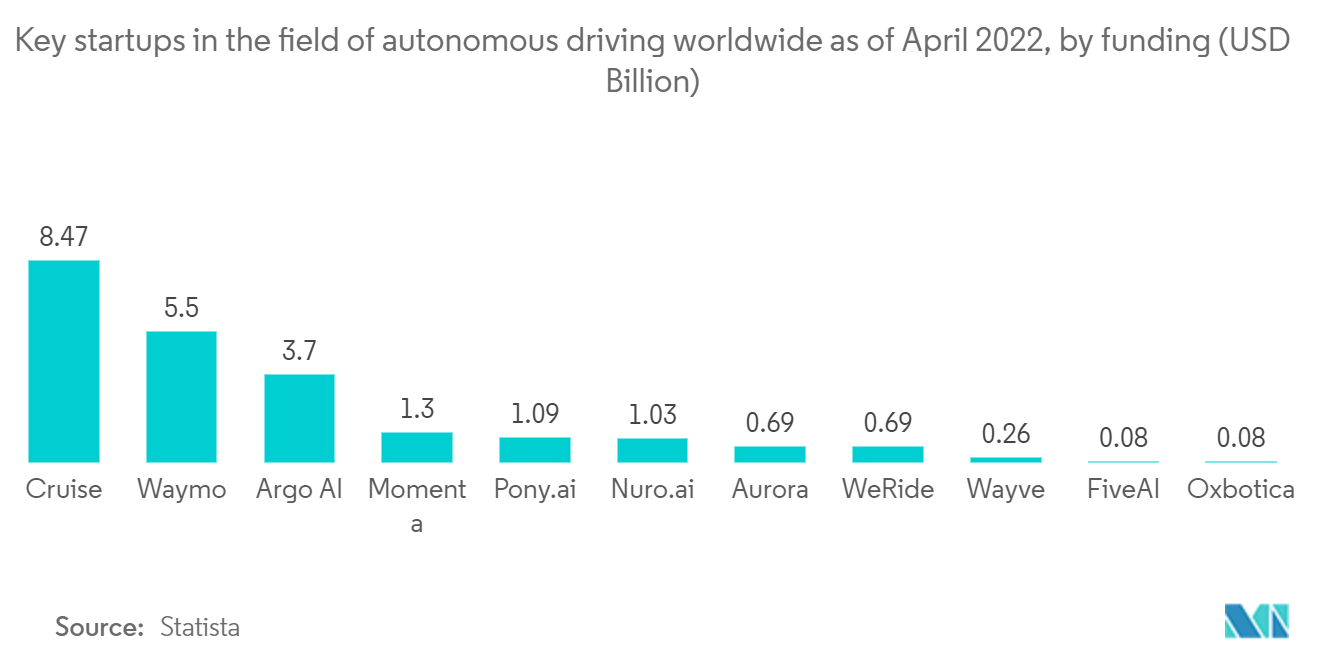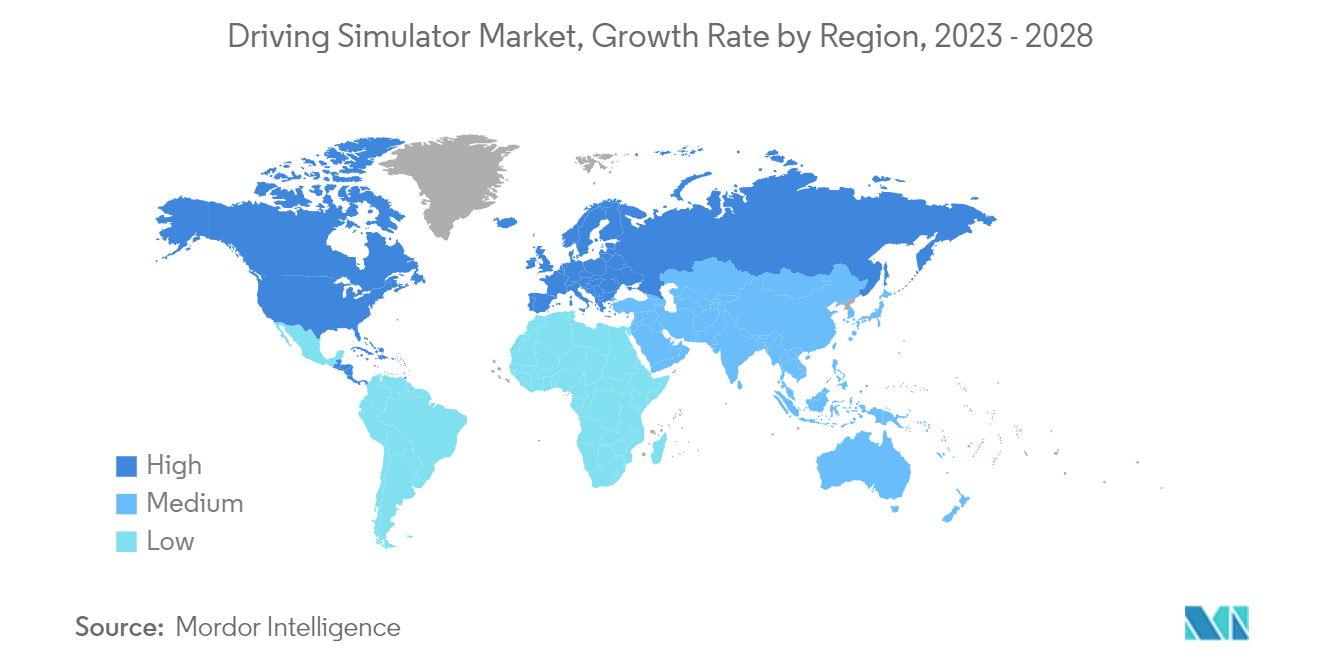Market Trends of Driving Simulator Industry
Autonomous Vehicle Acts as a Growth Engine for the Market
Autonomous vehicle makers are working hard to address the issue of autonomous vehicle safety when they are deployed on public roads. These players believe that autonomous vehicles will be far safer drivers than human drivers. This standard necessitates a large increase in existing testing installations.
However, while testing of driverless vehicles on actual roads has expanded in recent years, safety worries about autonomous vehicles are prompting market firms to engage in simulator testing for autonomous vehicles, as autonomous vehicles require a massive amount of data collection and processing. The data is shared among IoT-connected automobiles and wirelessly transferred to a cloud system to be examined and utilized to improve automation.
Several key market companies are substantially investing in the development of testing simulation systems and software for autonomous cars for these vehicles to be released on the road with considerably higher safety ratings. For instance,
At the most recent CommunicAsia 2022 trade show, MORAI, a Korean company that creates simulation technology for autonomous vehicles, demonstrated its MORAI SIM Drive, a "true-to-life autonomous vehicle driving simulator.' As an autonomous vehicle and autonomous system, MORAI develops simulation tools and solutions.
The realistic driving simulator for autonomous vehicles, MORAI SIM Drive, can verify autonomous vehicles and offer simulation environments, sensor data, and vehicle models that are exact replicas of the real thing. MORAI SIM Drive automates building virtual environment and offers accurate network representation with HD map and a high-performance 3D graphic engine (Unity).
Vehicle manufacturers are investing heavily in autonomous car technology and entering partnerships to develop the best autonomous vehicle, as autonomous vehicles require enormous data collecting and processing. The entire data is shared between IoT-connected cars and uploaded wirelessly to a cloud system to be analyzed and used to improve automation.
- In December 2021, Honda R&D Co. extended its long-term relationship with Ansible Motion after commissioning the latest advanced Delta S3 DIL simulator. With its larger motion space and increased dynamic range, the versatile simulator would enable the efficient development of future road and race vehicles and their associated technologies at its Sakura engineering facility.
- In March 2021, Volvo Group signed an agreement with NVIDIA to jointly develop the decision-making system of autonomous commercial vehicles and machines. Utilizing NVIDIA's end-to-end artificial intelligence platform for training, simulation, and in-vehicle computing, the resulting system is expected to be designed to handle fully autonomous driving on public roads and highways safely.
- In January 2021, General Motors announced they had entered a long-term strategic relationship with Microsoft to accelerate the commercialization of self-driving vehicles. The companies are expected to bring together their software and hardware engineering excellence, cloud computing capabilities, manufacturing know-how, and partner ecosystem to transform transportation.
With OEM's focus on automated driving soon and subsequent growth of electric vehicles is anticipated to drive the demand for driving simulators, especially for testing and research by the OEMs operating in the market.

Europe is Expected to Lead the Market
Europe is led by Germany, one of the global most technologically superior markets. There is rapid growth for Level 2 and Level 3 autonomous cars in this region, equipped with advanced driver assistance systems like collision detection, lane departure warning, and adaptive cruise control.
From driver instructor academies to the race track, driving simulators are increasingly used as strategic tools in training education for drivers and racers. Moreover, the driving simulator will be deployed to assess ride and handling, NVH (Noise, Vibration, and Harshness), human-machine interface, and hardware in the loop in the hope of accelerating the rate of innovation in the overall vehicle development process while reducing the number of physical prototypes, and development time and costs.
The German driving simulator market is booming due to various investments and purchases ensured by utility partners. For instance,
- In April 2022, Simulation and driving simulator developer VI-grade announced that an extended version of its DiM250 Dynamic simulator had been adopted by long-standing customer Honda. Honda's newly acquired DiM is the second VI-grade Dynamic simulator within the Honda Group, with the company's R&D site in Offenbach, Germany, relying on a version of the DiM250 simulator for vehicle development and testing since 2018.
- In February 2022, Bosch could expand its expertise in automated driving and strengthen its market position by acquiring Atlatec, a developer of high-definition maps for autonomous driving and simulation.
Several utility platforms and companies understand the deep readiness of driving simulators and thus actively invest in research and technologies to come up with advanced and reliable stimulation solutions. For instance:
- In May 2022, Thales, based in France, completed its acquisition of Switzerland's RUAG Simulation and Training (RUAG S&T). All 500 RUAG Simulation and Training (RUAG S&T) employees have transferred to Thales, which employs approximately 900 people. Thales is now one of Europe's leading companies in the development and supply of simulation and training for the military, as brought to users by Uniwest. RUAG S&T made around €90 million (US$94.5 million) in sales last year.
Thales claims that the consolidation will expand its footprint in the land market while maintaining its expertise in helicopters and military aircraft solutions. This acquisition also allows it to strengthen its local footprint in France, Switzerland, Germany, and the United Kingdom, while expanding its presence in the United Arab Emirates and Australia.
Considering these ongoing developments and purchases for driving simulators in Germany, demand for the same is expected to witness a high growth rate during the forecast period.

